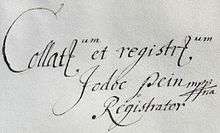Manu propria
.png)

Manu propria (Latin for '[signed] with one's own hand'), abbreviated to m.p. or mppria is a phrase sometimes used at the end of typewritten or printed documents when there is no handwritten signature. It is typically found just after the name(s) of the person(s) who would have signed the document if it had not been printed or typewritten.
It is also found in several ancient documents in front of or after the writer's signature at the end of the document.
History
- Medieval period
Richly decorated manu propria signs were frequently used by medieval dignitaries and literates to verify the authenticity of handwritten documents.
- 18th century
mppria was commonly used in the 18th century. However, it was not only used for Latin documents.
- Full autograph title-page of Symphony no.97 by Joseph Haydn which reads 'Sinfonia in C/di me giuseppe Haydn mppria. '[1]
- Adelsbrief André Falquets[2]
- From the 19th century
Later, official documents were routinely accompanied with this abbreviation, for example declaration of war on Serbia by Emperor Franz Joseph from 1914 ends with m.p..
Usage today
Ordinary personal cheques frequently include the abbreviation at the end of the signature line.
- By country
Some of the countries that still regularly use manu propria include:
- Albania in official documents: d.v. (Albanian: dora vetë)
- Austria: e. h. (Austrian German: eigenhändig)
- the Czech Republic: v. r. (Czech: vlastní rukou)[3] or occasionally the Latin abbreviation m.p.
- Germany: gez. (German: gezeichnet)
- Hungary in official documents: s.k. (Hungarian: saját kezűleg).
- Slovakia: v. r. (Slovak: vlastnou rukou)
See also
References
- ↑ Early Music, Vol. 10, No. 4 (Oct., 1982), pp. 496 and footnote nr. 5: 5The contraction of manu propria and of the date is usual
- ↑ Diploma Nobilitatis Andrea Falquet
- ↑ See e.g. Czech Technical Norm ČSN 01 6910 6910:2007 Úprava písemností zpracovaných textovými editory. Online Language Handbook in Czech